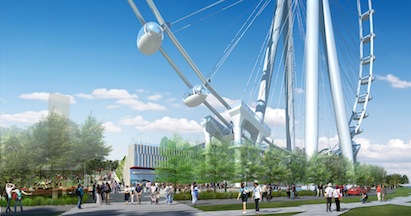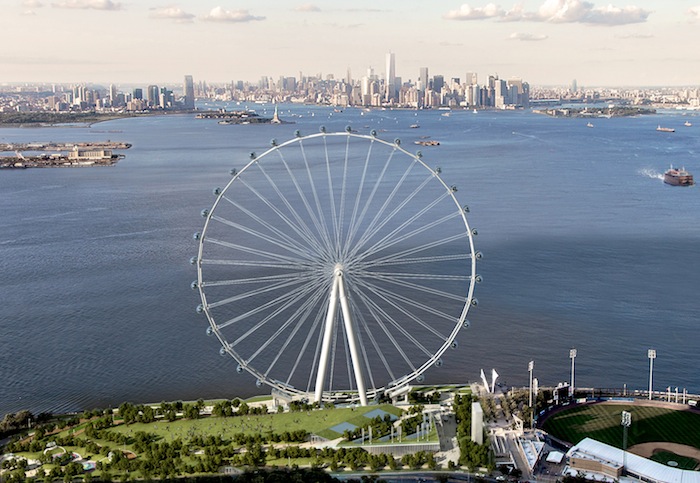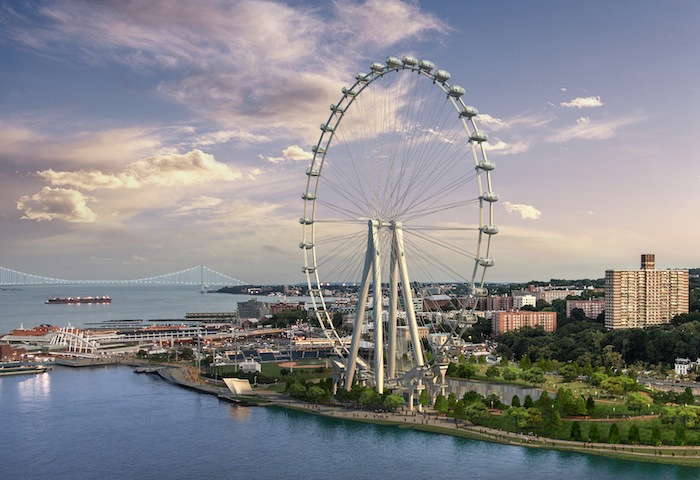The New York office of Perkins Eastman has announced that the New York Wheel, located on the north shore of Staten Island’s St. George neighborhood, was approved by City Council on October 30 and construction is scheduled to begin in 2014. The approval process has been over a year in the making since the project was first announced by the office of Mayor Bloomberg last September. Perkins Eastman is serving as design architect for the on-site 100,000 square-foot Terminal building.
Perkins Eastman will work closely with Richard Marin, CEO of New York Wheel LLC, and landscape architecture firm M. Paul Friedberg and Partners. The development will comprise retail, entertainment, dining and open space amenities amidst a compelling, integrated waterfront site that will attract millions of tourists and residents year round. Scheduled to open to the public in 2016, this currently underused shore land adjacent to the ferry terminal will become a dynamic mixed-use district. In addition to the 630-foot observation wheel, engineered by the designers of the London Eye, key components to the site will include the Terminal building, a 950-car parking garage, a bus storage facility, and an extensive landscape and sustainability program designed to provide a variety of open spaces. The Perkins Eastman design team is led by Principals Stanton Eckstut FAIA, Navid Maqami AIA, LEED AP, and Associate Principal Jonathan Cohn AIA, LEED AP.
The Terminal and its landscaped roof deck will link the water’s edge with the existing fabric of the site, offering expanses of public space for recreation, picnicking, promenade walks, cultural activities and more. “The design is intended to blur distinctions between architecture and landscape,” says Maqami, who is serving as Design Principal on the project. “The Terminal and its surrounding area will frame the iconic structure of the Wheel while providing great places that connect Richmond Terrace to the waterfront.”
While situated above grade level, the building was inspired by and designed to be part of the landscape itself, while meeting the highest standards for sustainable design and resilient waterfront development. The building’s generous interior will offer visitors clear sight lines to the Wheel, New York Harbor and beyond. Program spaces include ticketing, exhibition space, food and beverage areas, and retail opportunities. Given its proximity to the shoreline and the sustainable energy the site will draw from wind, water and sun, the Terminal building will continually devote space to educational exhibitions on alternative energy, green and resilient design, and the history of New York City, among other topics.
About Perkins Eastman
Perkins Eastman is among the top design and architecture firms in the world. With 700 employees in 13 locations around the globe, Perkins Eastman practices at every scale of the built environment. From niche buildings to complex projects that enrich whole communities, the firm’s portfolio reflects a dedication to progressive and inventive design that enhances the quality of the human experience. The firm’s portfolio includes high-end residential, commercial, hotels, retail, office buildings, and corporate interiors, to schools, hospitals, museums, senior living, and public sector facilities. Perkins Eastman provides award-winning design through its offices in North America (New York, NY; Boston, MA; Charlotte, NC; Chicago, IL; Pittsburgh, PA; San Francisco, CA; Stamford, CT; Toronto, Canada; and Washington, DC); South America (Guayaquil, Ecuador); North Africa and Middle East (Dubai, UAE); and Asia (Mumbai, India, and Shanghai, China).
About The New York Wheel LLC
The New York Wheel, located on the North Shore of Staten Island, will be the tallest observation wheel in the world and the only attraction of its kind in New York City. The 630-foot (roughly 60-story) Wheel will feature thirty-six capsules, each carrying up to 40 passengers, that will offer incomparable views of Lower and Midtown Manhattan, the Statue of Liberty, New York Harbor, and beyond both the Verrazano and the George Washington Bridges, for the duration of each 38-minute revolution. The attraction will accommodate as many as 1,440 people per trip, and will welcome as many as 30,000 visitors each day and an anticipated 4 million visitors per year.
The New York Wheel project was originally proposed in response to the New York City Economic Development Corporation’s Request for Expressions of Interest (RFEI) released in 2011 for projects that would increase economic growth, boost tourism, and create jobs on Staten Island. Meir Laufer is the founder of New York Wheel. The New York Wheel has been designed by a team from Starneth B.V., Perkins Eastman Architects and M. Paul Friedberg & Partners. It is expected to begin construction in 2014 with a grand opening scheduled for 2016. For more information about the New York Wheel visitwww.newyorkwheel.com
About M. Paul Friedberg and Partners
MPFP, LLC / M. Paul Friedberg and Partners, established in 1958, is one of the most well known and highly regarded interdisciplinary landscape architecture, urban design and planning firms in the country. Lead by Rick Parisi, FASLA, the firm provides a full range of services including planning, programming, designing, engineering and construction supervision of mixed use, commercial-institutional facilities, and new residential communities, with an emphasis on the creation of parks, play environments, and plazas. MPFP provides the experience and the capability to direct complex projects from concept to implementation, with a sense of continuity and a detailed understanding of site and audience. The firm is also proficient in a variety of environmental analysis, product design and development, graphics, civic and promotional programming, research, and community participation activities. MPFP is highly successful in working with municipalities, arts groups, architects, and artists. From their office in New York, the firm has completed projects in numerous international locations including Israel, Brazil, Greece, Turkey, Egypt, India, Hong Kong and Japan. The quality of their work has been recognized with over 100 professional honors and awards from organizations such as the American Society of Landscape Architects, the American Planning Association, the American Institute of Architects, the Building Stone Institute, and the Municipal Arts Society. For more information visit www.mpfp.com
Related Stories
| Nov 26, 2013
Construction costs rise for 22nd straight month in November
Construction costs in North America rose for the 22nd consecutive month in November as labor costs continued to increase, amid growing industry concern over the tight availability of skilled workers.
| Nov 26, 2013
Design-build downsized: Applying the design-build method in an era of smaller projects
Any project can benefit from the collaborative spirit and cooperative relationships embodied by design-build. But is there a point of diminishing return where the design-build project delivery model just doesn't make sense for small projects? Design-build expert Lisa Cooley debates the issue.
| Nov 25, 2013
Insider tips on how to get picked a BD+C 40 Under 40 winner
We just posted the Entry Form for our 9th Annual BD+C "40 Under 40" competition. Frankly, the Entry Form is just the basic data. The real meat of your entry is your Personal Statement.
| Nov 25, 2013
Building Teams need to help owners avoid 'operational stray'
"Operational stray" occurs when a building’s MEP systems don’t work the way they should. Even the most well-designed and constructed building can stray from perfection—and that can cost the owner a ton in unnecessary utility costs. But help is on the way.
| Nov 25, 2013
Manufacturers race to offer EPDs, HPDs in response to LEED v4
Under LEED v4, projects are awarded points for using at least 20 building products that have issued Environmental Product Declarations or Health Product Declarations. In response, manufacturers are racing to offer EPDs and HPDs for their product lines.
| Nov 25, 2013
Electronic plan review: Coming soon to a city near you?
With all the effort AEC professionals put into leveraging technology to communicate digitally on projects, it is a shame that there is often one major road block that becomes the paper in their otherwise “paperless” project: the local city planning and permitting department.
| Nov 22, 2013
Health Product Declaration Collaborative to develop protocol for third-party verification of HPDs
Seven leading product sustainability assessment companies partner with the HPD Collaborative to develop the verification and quality assurance protocols.
| Nov 22, 2013
Kieran Timberlake, PE International develop BIM tool for green building life cycle assessment
Kieran Timberlake and PE International have developed Tally, an analysis tool to help BIM users keep better score of their projects’ complete environmental footprints.
Sponsored | | Nov 20, 2013
Four faces of curb appeal
The Furniture Row retail center in Charlotte, N.C., incorporates four specialty stores in a distinctive, efficient structure.
| Nov 20, 2013
Architecture Billings Index slows in October; project inquiries stay strong
Following three months of accelerating demand for design services, the Architecture Billings Index reflected a somewhat slower pace of growth in October. The October ABI score was 51.6, down from a mark of 54.3 in September.


















